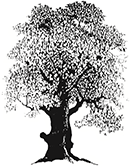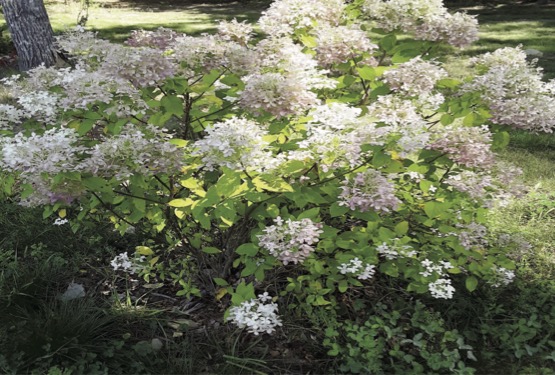MAINE-LY GARDENING: Flowering shrubs for Central Maine – summer into fall
 by Jude Hsiang
by Jude Hsiang
After considering some spring flowering shrubs we’ll be enjoying soon, let’s think about shrubs that will provide us with floral displays during the coming months. Previously I wrote about the big-leaf hydrangeas because the correct time for pruning – if needed at all – depends on when the leaves appear on the stems that can look like dead sticks. Many people have learned the hard way to wait for the leaves to appear before assuming the stems are dead. The result is few or no flowers because the flower buds had been formed in the previous fall.
There are other species of Hydrangeas that are less confusing. The large panicle hydrangeas are very cold-tolerant shrubs we see thriving well north of us. They are named for their cone-shaped flower clusters – panicles – which open white (or even pale lime green, then change to rosy shades as the weather cools. The flowers can then be clipped off in fall, allowed to dry for long-lasting arrangements, or just left on the plant all winter. If punning is necessary – and it may never be needed – it’s best done in late winter-early spring because the new flower buds will be formed in spring.
Climbing hydrangeas can be grown on a trellis or against a tree. They will grow to be quite large – up to 50 feet – so they will need some planning before planting. Another easy-care plant, this vine doesn’t need pruning unless it begins to grow to large, when winter or early spring is best.
Oakleaf hydrangeas are another larger shrub maturing to be wide and rounded, unlike the taller panicle species. They are named for the large, toothed leaves reminiscent of oak leaves. Unlike the species mentioned previously which originated in East Asia, they are native to the southeast of us. Generally white flowered, some varieties have pink to red-pink flowers in their large clusters. In recent years smaller oakleaf varieties have come on the market making them more easily used in smaller spaces. Like the hydrangeas mentioned in this article, they can be pruned in late winter, should they ever need it.
One more type of hydrangea that is easily grown in our area is the smooth hydrangea which is native to the East Coast from southern New York and further south. Their care is similar to the other hydrangeas in this article. There is such a wide range of hydrangea species, with new varieties being introduced to the nursery trade, that almost any garden can host one or more.
Hydrangeas take center stage in summer, but several other native shrubs whose flowers are easily ignored can have a place in the garden. The famous Maine lowbush blueberries that carpet the barrens have taller cousins that make good additions to the garden. Different named varieties produce the fruit at different times over the summer so by planting several of them, we can have a long blueberry season. Of course, we have competition from the birds who love them so much that they don’t even wait until the berries are ripe. If fruit is the most important reason for having these native shrubs, you may need to use bird proof netting, available at garden centers. If the netting is simply draped over the plants, birds will sit on the net and reach right through to grab the berries. But if you are willing to share, high bush blueberries will reward you with some of the fruit and beautiful red fall foliage.
Another native shrub to consider is winterberry. The red berries appeal to us for their beauty, and they aren’t high on the list of favorites of most birds either. We usually see them in wet areas like the edge of a pond or swamp, but they will do fine in average garden soil, too. Winterberries are part of the holly genus and most members of the group have separate female and male plants. Horticulturalists routinely give them names according to their gender, like the male known Jim Dandy. Another characteristic of winterberries is that there are some varieties found in our northern area, while others are common further south. For best results, a knowledgeable nursery or garden center will guide you in purchasing a pair, for more, of plants that will guarantee lots of berries on your female winterberries.
There is another native shrub that is a fun addition if you have a wet area in your yard. You may have seen button bushes with their spikey, round white flowers that look like sputniks. They can grow right at the water’s edge and surprise visitors to your garden.
© Judith Chute Hsiang
Jude Hsiang Is a retired Extension Master Gardener instructor and member of the China Community Garden.
Responsible journalism is hard work!
It is also expensive!
If you enjoy reading The Town Line and the good news we bring you each week, would you consider a donation to help us continue the work we’re doing?
The Town Line is a 501(c)(3) nonprofit private foundation, and all donations are tax deductible under the Internal Revenue Service code.
To help, please visit our online donation page or mail a check payable to The Town Line, PO Box 89, South China, ME 04358. Your contribution is appreciated!



Leave a Reply
Want to join the discussion?Feel free to contribute!